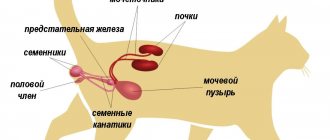Unfortunately, tooth extraction in cats is quite common, since many animal owners, out of ignorance, do not care for the cat’s oral cavity. Therefore, they come to the clinic with advanced cases and the teeth are removed.
Tooth extraction in cats occurs only when treatment no longer helps. It must be remembered that many dental diseases are asymptomatic, so it is necessary to periodically examine the oral cavity so that you do not have to resort to such a procedure.
In what cases does a veterinarian recommend tooth extraction?
Let's look at the cases in which teeth are removed.
- Incorrect placement of milk or molars, which interferes with the normal functioning of the animal - the soft tissues of the oral cavity are damaged.
- In severe cases, where conventional treatment has not yielded results - feline lymphoplasmacytic stomatitis.
- Teeth that are close to each other is called crowding. In this case, there is a risk of getting sick because Food will accumulate between the teeth and this will lead to an inflammatory process.
- Internal root resorption
- External root resorption
- Milk teeth that did not fall out on time on their own, but the molars have already begun to grow and the milk teeth interfere with the growth of new teeth.
- Teeth located under the gum mucosa are also subject to removal. They have not erupted, but a cyst may form under the gum and this will harm the adjacent teeth.
- The indication for tooth extraction is periodontal disease.
- Odontoclastic resorptive lesion of teeth – classes 2,3,4
Tooth extraction is carried out only under anesthesia. After tooth extraction, your pet must have the wound sutured, otherwise there is a risk of infection, and the wound will take a long time to heal.
Symptoms of a tooth abscess
The inflammatory process in the tissues of the tooth and gums occurs in stages and is accompanied by different symptoms:
- At the beginning of development, discomfort appears, slight swelling, gum bleeding is possible when brushing teeth, and pain is sensitive when pressed.
- In later stages, swelling increases, and a reaction to hot and cold foods appears. There is prolonged pain and an unpleasant odor. In addition to local changes, the abscess is accompanied by enlarged lymph nodes in the neck, increased body temperature, and general malaise.
A bitter aftertaste is noticeable in the mouth, and a change in the shade of the tooth body is possible. It is important to remember: the symptoms of gum abscess can manifest themselves in different ways - everyone has their own pain sensitivity threshold and perceives signals subjectively. Therefore, you should not wait for acute conditions; a reasonable step is to visit a dental clinic at the first incomprehensible sensation.
The procedure for removing teeth from a cat or how to pull a tooth out for a cat
Provide your pet with proper dental care: brush his teeth at least once a week, periodically remove tartar, give vitamins and periodically visit a veterinarian for an oral examination. Even if a cat’s tooth was pulled out and everything else is fine, this does not mean that further care is not needed.
Only a veterinarian can remove a tooth from a cat after first administering anesthesia. If a cat's teeth have been removed, it is necessary to first check the condition of the gums in this place so that inflammation does not appear.
Treatment
This process directly depends on the nature of the damage. Damaged dentin is treated with fluoride and sealant. If the fang is more damaged and cannot be restored to a healthy state by any means, it is removed.
We recommend the article: What causes purulent wounds on the cheeks of cats?
In some cases, the animal is given a filling. Special plates are used if the crack is small. If the crack appeared because the jaw was injured and, in addition to problems with the teeth, abrasions and scratches appeared, then the jaw is treated first. The veterinarian is able to return the tooth to its original place if it has shifted. In this case, the main thing is to immediately contact a veterinary clinic, because an inflammatory process may begin.
Cats quickly adapt to life without a fang, and this will not affect his abilities or behavior in any way. The animal will be able to chew food easily and the absence of a fang will not cause any discomfort.
The cat broke a tooth: what to do?
If your cat has a broken tooth. First of all, check whether there is inflammation, what condition the other teeth are in, whether it hurts the cat to eat, whether there is discomfort when eating, and in general, pay attention to the behavior of the animal; perhaps the cat has a toothache.
If a cat has a broken tooth and it does not cause concern to the animal, there is no need to do anything; at home this is not as important as for wild cats for hunting. If there are still nuances, something is confusing, it’s better not to delay.
If your cat breaks a tooth or knocks it out at the root, you can get a crown. In some cases, it is necessary to remove a cat's tooth. The same thing is done if the cat knocks out a tooth.
Causes
A tooth can break for many reasons. A small crack in the enamel leads to the destruction of dentin and exposure of the pulp, which can lead to tooth loss. The tooth root or crown may also be partially or completely damaged.
Typically, dental injuries in pets occur due to bad falls, car accidents, fighting with each other, or injuries to the jaw bones.
A pet’s teeth can break above, below or at the gum level, and the fracture itself can be either vertical or horizontal; subsequent treatment will depend on these indicators.
Cat's tooth is loose
If a cat's tooth is loose, there may be several reasons for this. An adult cat may have a loose tooth due to a lack of vitamins or poor nutrition. Also note that you should not give too much fish to your cat, as vitamin B is washed out of the animal’s body. If a kitten’s tooth is loose, it may be a baby tooth and will soon be replaced by a molar. In any case, if you are not sure about the correctness of the treatment or prevention you have chosen, contact your veterinarian, he will really help determine the causes of the disease, and not just see the consequences.
| In our cattery you can “buy a real British kitten.” We have many different colors, we will help you choose and answer all your questions! |
What is tartar
Microbes settle on the enamel during food consumption and digestion and multiply under the influence of a moist, warm environment near the gums. If they are not removed within the next fifteen hours, the process of mineralization of these organisms will begin.
After seven days, mineralization becomes irreversible, and after six months, the “dead” microorganisms turn into natural stone, the shade of which varies from yellow to dark brown.
Thus, up to 30% of tartar consists of organic compounds, and the amount of inorganic components gradually increases from 70 to 90%.
Additional Information. It is necessary to understand that the composition is not constant and varies depending on the period of mineralization. The amount of organic matter decreases with each day of hardening.
Remember that after just a couple of days of lack of careful hygiene, the film forms a rough surface that attracts even more plaque.
In addition, the occurrence of gum inflammation is beneficial to the stone, since this increases the amount of periodontal fluid, which contains the necessary salts and proteins to increase the colony of microorganisms and further mineralization.
Possible complications
Since bruising of a gum, tooth or other tissues in the oral cavity is always individual, it is impossible to give reliable predictions about recovery and possible complications. It usually takes several visits to the dentist to carry out the necessary examinations and procedures, after which a complete recovery can be established. If you do not approach the treatment process responsibly, you can get the following complications:
- darkening of the enamel (due to the penetration of pollutants through cracks, blood entering the pulp and disruption of the nutrition of dental tissues);
- death of pulp cells and formation of necrotic areas leading to tooth death;
- chronic inflammatory processes (pulpitis and periodontitis) leading to more serious consequences.
Very often, a tooth bruise leads to serious but hidden injuries. The victim may feel minor pain and think that everything will go away soon. However, this is not a reason to avoid qualified medical care. The sooner an examination is carried out in a dental office, the greater the likelihood that all consequences will be eliminated, complications will be avoided and the tooth will be as healthy as possible.
Seal + pin = Error?!
Since 1792, dentists have been searching for the perfect tooth post. Almost 300 years have passed, and the mythical perfect pin has not been found. Is it really necessary?
Valentina Vladimirovna Khalyavka, general director and orthopedic dentist of the Dental Clinic “Dentist”, speaks about the problem of treating periodontal diseases. (Article from the archives of the magazine “Women’s Health” Copyright entirely belongs to dentist V.V. Khalyavka)
Features of dental pinning, or why specialists at the Dentist clinic prefer more modern tactics.
Filling with a pin - what is it?
Increasing the strength of a tooth means extending its life. One of
The most popular solution to this problem for a long time was the use of pins. They are a ready-made structure that looks like a threaded rod. After expanding the canal mechanically, the pin is fixed directly into the canal of the tooth root, with cement, or screwed in like a screw, after which the remaining stages of restoring the damaged tooth are carried out. A filling with a pin is very often used in practice by dental therapists without a crown and orthopedic dentists with a crown.
IMPORTANT:
Pinning teeth and covering them with a crown is a gross orthopedic mistake, as well as a therapeutic one, which in the future will lead the patient to tooth extraction with subsequent implantation. That is why the most modern dental centers opt for other technologies.
Crown or filling on a post.
The question of which is better, a pin with a filling or a crown, is still relevant for many dentists. However, clinic specialists
“Dentist”, based on long clinical studies and personal observational experience, consider the choice in favor of dental pinning to be unsafe and extremely harmful. In clinical studies, it was proven that a filling on a pin leads to the removal of teeth in 70% of patients. Extraction (removal) of teeth in the roots of which metal pins were installed was carried out in connection with a root fracture. The reason for this is that pinning negatively affects the biomechanics of the tooth. During the endodontic protocol (treatment), the canal is widened, which has an acceptable limit. When a pin is installed, the expansion of the canal goes beyond the permissible limits and the walls of the tooth root become very thin. Inserting a pin into the root leads to a wedging effect. When chewing, the action of external forces becomes excessive, deformations occur, which lead to rupture or fracture of the root. Extraction (removal) of teeth in the roots of which metal pins were installed was carried out due to a root fracture.
IMPORTANT:
According to specialists at the Dentist clinic, the use of pins in everyday practice is a gross mistake, which in the future will lead to tooth extraction.
Thanks to modern technologies and the use of the latest generation of light materials (Enamel and Estet-X), our doctors carry out large dental restorations without the use of pins
. Restorations, like fillings made from the latest generation materials, serve their owners for a long time, more than 15 years!
For teeth with severely damaged coronal parts, we recommend core inlays
made of metal, inlays made of composite materials and zirconium dioxide. These additional expenses will definitely pay off in that you will not soon have to resort to tooth extraction where a filling was previously installed on a pin, further installation of a bridge structure, or implantation. Patients fully support this approach and consider the clinic one of the best in Moscow, which is clearly reflected in their positive reviews.
What dangers and harm does dental pin therapy pose for patients?
I began my career as a therapist-orthopedist-dentist after graduating from dental institute and residency 25 years ago. Few people know that the work of a dentist of any specialty requires the doctor to have in-depth knowledge of physics, namely mechanics and biomechanics, strength of materials and chemistry. And this is not without reason. Did I surprise you?! The entire chewing function of the jaw apparatus operates and works according to the laws of physics. Ignorance by a dentist of the basics of physics and mechanics leads our patients to tooth extraction, breakage of orthopedic structures, rejection of implants, and everything that is called medical error!
Until now, I am faced with metal pins twisted into the canals of the tooth, a “dentist” and I see the consequences that lead to fracture of the roots of the teeth, decementing of crowns, bridges and always, as a result, removal! Patients pay special attention to the issue of preserving natural teeth. The desire to preserve teeth for a long time also increasingly extends to those teeth whose crowns are severely damaged.
IMPORTANT:
Patients are not certified specialists in the field of dentistry; they often do not understand the principles of this or that treatment path, and in fact they should not understand!! They turned to a specialist dentist who will explain, suggest and help!
And so the “walk through agony” begins. A song as old as the world that “dead teeth” (the nerve has been removed) are very fragile and they must be strengthened with a metal pin, or a non-metal one, it is simply necessary to reinforce them, since the filling will not hold, and crown and bridge! If today the dentist does not have knowledge and scientific evidence about the dangers of “pin therapy,” I will try to reach out to patients. After all, these are their teeth and they want to preserve them at any cost!
And how great it sounds: “A restored tooth with a pin will last much longer (at least 5-7 years) and will withstand increased chewing loads.
IMPORTANT:
The opinion that: “Restorations using root pins are a good treatment method that sufficiently ensures fixation of the restoration during orthopedic work” is deeply erroneous and has long been outdated!
Scientific research.
"Long-term clinical studies that have been conducted
Axelsson et al.
(1991) over a 15-year period clearly showed that pins and screws placed in the root canal had an adverse effect on the prognosis of the tooth. At the same time, a total of 71 teeth were removed from 59 patients, of which 48 teeth (69%) were removed after endodontic treatment and installation of a root pin. Extraction of these teeth was performed due to a root fracture. Also Eckerbom et al. (1991) indicated in their clinical studies, which were carried out over 5-7 years, that the rate of extraction of teeth in the roots of which metal pins were installed was higher than that of teeth without a root post.” All these research observations were always available, and each doctor could obtain reliable information if desired.
It has been proven that the root post:
- Does not stabilize the tooth root or strengthen it.
- Does not contribute to the retention of the filling in any situation.
- Does not contribute to the redistribution of load during chewing.
Consequences of the pin + filling design.
- Weakens the root due to its strong expansion.
- The pin + seal makes the structure heavier.
- Leads to root fracture - fracture.
- Removal followed by prosthetics and implantation.
- Corrosion of stainless steel pins, which leads to tooth root fracture.
Why do all pins negatively affect the root of the tooth?
From the physics course we know that all solids experience deformation: shear, compression, bending, torsion. Depending on the material, each item has its own margin of safety. Strength is the ability of a material to resist destruction and for everyone it has its own limit. When carrying out endodontic treatment, we are forced to intervene in the biomechanics of the tooth. Carry out instrumental treatment, namely expansion of the canal. But there is a permissible limit of expansion, beyond which we actually weaken the foundation of the tooth. The human tooth, like the bone (periodontal) in which it is located, experiences elastic deformation, compression and tension deformation during chewing, but perceives it adequately. But as soon as the action of external forces becomes excessive, plastic deformations occur, which lead to destruction.
IMPORTANT:
When installing a screw pin, a wedging effect is created, the pin moves, uneven distribution of the chewing load and, as a result, root rupture.
But what about elastic pins? Yes, apparently they at least guarantee that the tooth root will not be torn in the future. And there is no convincing evidence about the benefits of these pins.
What is the price of pin therapy?
Pinning teeth and covering them with a crown is a gross orthopedic mistake, as well as a therapeutic one, which in the future will lead the patient to tooth extraction with subsequent implantation. This is such a high price for something harmless and not so
an expensive filling made of medium quality material on a pin! Modern technologies and high-quality materials make it possible today to carry out large dental restorations without the use of pins
.
Restorations, like fillings made from the latest generation materials, serve their owners for a long time. For teeth with severely damaged coronal parts, there are more durable and safe designs: core inlays, inlays made of composite materials and zirconium dioxide.
Of course, these are additional costs, but they are worth it, since you will not have to start traditional bridges or implants in two years or less.
IMPORTANT: The patient considers the situation hopeless, the way out of which he does not like.
Dentistry has firmly become commercial in the 21st century, and competition is very high in the market for these services.
There is nothing wrong with that and this is natural. The question is about the quality of services, their adequacy and benefit for the patient? I never followed the lead of patients, and did not allow roles to be changed; the patient became a doctor, the doctor became the executor of his desires. This is an important point, and the material aspect has never been a priority for me in such situations. The moral and professional aspects have always been the leading ones for me when working with such patients, and there were quite a few of them. The answer was and is always the same: “Apparently, you need a doctor of “higher qualification” and “with a different level of knowledge”!!” “The only thing satire should do is alarm. If the addressee of satire is not complete……., he will be wary, sensing arrows” Alexander Shirvindt.











